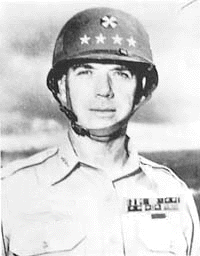
|
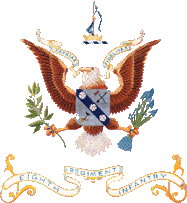


|
He married Helen Hazel Moore (1894-1984) of Long Beach, California, in December 1915. (After his first
wife died in 1984, he remarried in November 1984 to the former Virginia Skinner-Higgens Wells (1919-1986).
General Van Fleet had three children (all with first wife):
- Dempsie Catherine (Mrs. Joseph McChristian) (1918-?)
- James, Jr. (1925-1952 A Korean War POW/MIA )
General James A. Van Fleet died 23 September 1992, aged 100, in Washington, D.C.,
and is buried at the Arlington National Cemetery, with both his first and third wives.
The following narrative is transcribed verbatim, announcing GEN Van Fleet's death:
Headquarters
Department of the Army
Washington, D.C.
24 November 1992
"The death of General James A. Van Fleet, on 23 September 1992 in Washington,
D.C., is announced with deep regret. He was a distinguished combat commander
in World War I, World War II and the Korean War.
"General Van Fleet was an officer of the highest ideals. His courage, sound
judgement, and superb leadership produced brilliant military achievements of
the greatest value to his country. With his passing the nation has lost a
faithful, valiant servant, and the United States Army, a commander of great
stature.
"General Van Fleet was born in Coytesville, New Jersey on March 19, 1892. He
entered the United States Military Academy where he was a standout fullback on
the undefeated team of 1914. He graduated and was commissioned a second
lieutenant of Infantry on June 12, 1915.
"Upon graduation from West Point, he was assigned to the 3rd Infantry
Regiment at Madison Barracks at Sackett's Harbor on Lake Ontario. In April
1916, Lieutenant Van Fleet was ordered, as a member of "The Old Guard" to
Eagle Pass, Texas, to serve under General Pershing in operations against
Pancho Villa. He was subsequently promoted to first lieutenant and then
captain, commanding a company in the 3rd Infantry Regiment.
"In July 1918, he went to France with the 6th Division and shortly afterward
assumed command of the 17th Machine Gun Battalion, with which he saw action in
the Gerardmer Sector and the Meuse-Argonne Offensive. Van Fleet received two
Silver Stars before being wounded in action on November 4, 1918, near Sedan,
France. After the Armistice, he remained on occupation duty with his
battalion until its return to the United States in June 1919.
"After a year with the Division at Camp Grant, Illinois, he was assigned to
the Reserve Officers Training Corps at Kansas State Agricultural College,
Manhattan, Kansas. In January 1921, he became Professor of Military Science
and Tactics at South Dakota State College, but in September of that same year
moved to the University of Florida. He was also the head football for the
Gator team.
"In February, 1925, General Van Fleet was assigned as battalion commander
with the 42nd Infantry in the Panama Canal Zone. After more than two years of
extensive maneuvers in the Panama Canal Zone, he returned to the United States
to become an instructor at the Infantry School at Fort Benning, Georgia. In
1928, he entered the Infantry School's advanced course from which he was
graduated in June 1929. He then returned to the University of Florida as
Professor of Military Science and Tactics. In 1933, General Van Fleet was
assigned to the 5th Infantry Regiment at Fort Williams, Maine. Two years
later he became an instructor with the Organized Reserves headquartered in San
Diego, California.
"On September 1939, he returned to Fort Benning, Georgia, to become a battalion commander in the 29th Infantry regiment. For two years, Van Fleet was in command of an outstanding battalion whose mission was to demonstrate for students of the Infantry School the correct way for Infantry to fight."
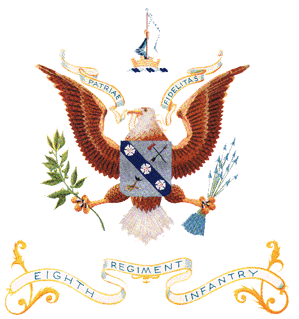
|
"In June 1941, he assumed command of the 8th Infantry Regiment, 4th Infantry
Division. He commanded this regiment for three years, conducting rigorous
combat training, amphibious exercises and maneuvers at Fort Benning; Camp
Gordon; Fort Dix, New Jersey; Camp Blanding, Florida; and many other stations
in this country. The regiment deployed to the European Theater in January,
1944, and was selected to spearhead the landing of the 4th Infantry Division
at Utah Beach on D-Day, June 6. After fierce combat from the beach to
Cherbourg, General Marshall along with Generals Eisenhower and Bradley
inspected the front. On the battlefield, General Eisenhower informed General
Marshall that General Van Fleet deserved great credit for his leadership and
successes and that for the past several years each commander over Van Fleet
had recommended that he be promoted. He asked why Van Fleet had not been
promoted. Marshall replied that he had been turned down because he was an
alcoholic. Eisenhower informed Marshall that Van Fleet had always been a
teetotaler. It turned out that Van Fleet had been confused with another
officer. His promotions came rapidly thereafter. He was assigned as
assistant commander of the 2d Infantry Division and promoted to brigadier
general. When General Bradley was asked to describe Van leadership he
replied, Colonel Van Fleet's leadership was 'best described by the rate at
which he was earning Distinguished Service Crosses - about three a day.' He
soon was transferred to command, in turn, the 4th Infantry Division in the
Siegfried Line in late September, and the 90th Infantry Division from October
1944 to February 1945.
"The 90th Infantry Division spearheaded Third Army's attack to cut off the
Fortress Metz, and the crossings of both the Moselle and Saar Rivers under
extremely difficult conditions. General Patton stated that the crossing of
the Moselle was the classic river crossing of all time. Early in January, the
90th Division was moved to the Bastogne Area, where it spearheaded the Third
Army's counter-offensive against the Ardennes Bulge. General Van Fleet was
then sent to England to command the XXIII Corps which had under it all the
field units then in the United Kingdom.
"On March 17th, 1945, he was placed in command of the III Corps at the
Remagen Bridgehead. Under his leadership, the bridgehead was rapidly
expanded. On March 26, the III Corps spearheaded the First Army's advance
deep into Germany and thence north to make possible the encirclement of the
Ruhr pocket. Under his direction, the III Corps attacked the east face of
this pocket, and by April 16th, had taken its assigned objectives and 105,000
German prisoners. The III Corps was reassigned to the Third Army on April 17,
and during the last two weeks of the war, advanced rapidly across southeast
Germany to the foot of the Austrian Alps.
"General Patton, in briefing a congressional delegation in his headquarters
in Bad Tolz, Germany stated that Van Fleet was the best of all combat generals
who served under him.
"With the cessation of hostilities in Europe, General Van Fleet, with his
battle-tested III Corps headquarters, was deployed in June, 1945 for the
Pacific through the United States. With the arrival of V-J Day, his
organization remained at Camp Polk, Louisiana until February 1946. He then
was assigned to command the Second Service Command, with headquarters at
Governors Island, New York. On June 7, 1946, following the reorganization of
the Zone of Interior into six Army Areas, General Van Fleet was appointed
deputy commanding general of the First Army at Governors Island. In December
1947, he was assigned to headquarters of the European Command at Frankfurt,
Germany, and two months later was transferred to the U.S. Army Group, American
Mission for Aid to Greece, with station at Athens. On February 19, 1948, he
became director of the Joint U.S. Military Advisory and Planning Group in
Greece, whose function was to provide operational advice to the Greek military
establishment down to and including divisional level. Under his guidance and
inspiring leadership the Greek military defeated and drove the Communists out
of Greece. A statue of the General stands in the town square of Kastoria in
Northern Greece where he had an advance headquarters. A bust of the General
made by Greece's foremost sculptor is on display in the III Corps Headquarters
building, named 'Van Fleet hall,' at Fort Hood, Texas.
"General Van Fleet returned to the United States in August, 1950 to assume
command of the 2d Army at Fort George G. Meade, Maryland."
"On April 11, 1951, he was appointed Commanding General of the Eight Army and
U.N. troops in Korea. General Van Fleet drove the Chinese Army north. He was
ordered to halt and to go on the defensive in order to achieve an armistice.
Van Fleet, shortly after his arrival in Korea, instituted a tremendous program
of retraining. In this regard, he established numerous military schools:
Infantry schools, Artillery schools, small unit officers schools, staff
schools, and even established a war college and most important of all for
leadership, a Military Academy - the 'West Point of Korea.' The Koreans
erected a life-size bronze statue of him in front of the Military Academy and
refer to him as 'The Father of the Korean Army.'
"General Van Fleet retired from active duty in 1953. In May, June, and July
1954, General Van Fleet conducted a survey of the military, economic, and
political situation in the Far East, traveling with the rank of Ambassador, as
special representative of President Eisenhower.
"In 1961, President Kennedy recalled the General to active service to conduct
a survey of National Guard and Special Service Forces units. He also
represented the United States as Ambassador at the coronation of the Shah of
Iran and at the Golden Jubilee of Emperor Haile Selassie of Ethiopia.
"For his exceptionally meritorious and distinguished service, Van Fleet's
awards and decorations include the Distinguished Service Cross with two oak
leaf clusters; The Distinguished Service Medal with two oak leaf clusters; The
Silver Star with two oak leaf clusters; The Legion of Merit with one oak leaf
cluster; The Purple Heart with two oak leaf clusters; The Combat Infantryman's
badge; The Army Commendation Ribbon; The Distinguished Unit Citation; and he
has received decorations from Greece, Korea, Iran, Ethiopia, Thailand, The
Philippines, The Republic of China, England, France, Belgium, The Netherlands,
and Columbia.
"Upon his retirement from the military, General Van Fleet continued his
service to the nation as a diplomat, businessman, author, athlete, hunter,
rancher, and Floridian. Until his death, he was the oldest living flag
officer in the United States Armed Forces.
"General Van Fleet's life was characterized by courage, dedication, vision,
patriotism, and 'The Will to Win.' These qualities earned him the respect of
all who knew him. The grief caused by the death of General Van Fleet is
deeply shared by all members of the United States Army.
"General Van Fleet is survived by his two daughters, Helen Elizabeth (widow
of Colonel Edward T. McConnell) and Dempsie Catherine (wife of Major General,
USA (Ret) Joseph A. McChristian), 2 grandsons, 5 granddaughters, and 12 great
grandchildren."
The information in this brief biography was provided by LTC Harold E. Raugh Jr., who is currently doing extensive research into General Van Fleet's background,
and hopes to publish an in-depth book about this great leader! If you served under
General Van Fleet at any time, he would appreciate interviewing you to find out more
about the life and character of this great man!
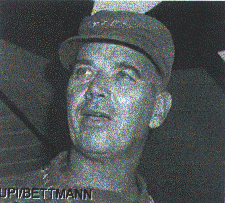
|

|

|
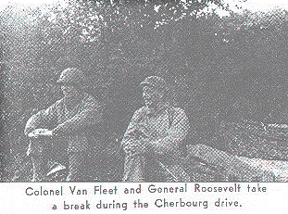
|
The 50 Most Important Floridians of the 20th Century !
Photo's At Page Bottom: Courtesy of Irving Smolens,
with graphics assistance from Sandy Easton !
8th Infantry Regimental Crest: Courtesy of Irving Smolens,
with graphics assitance from Sandy Easton !
